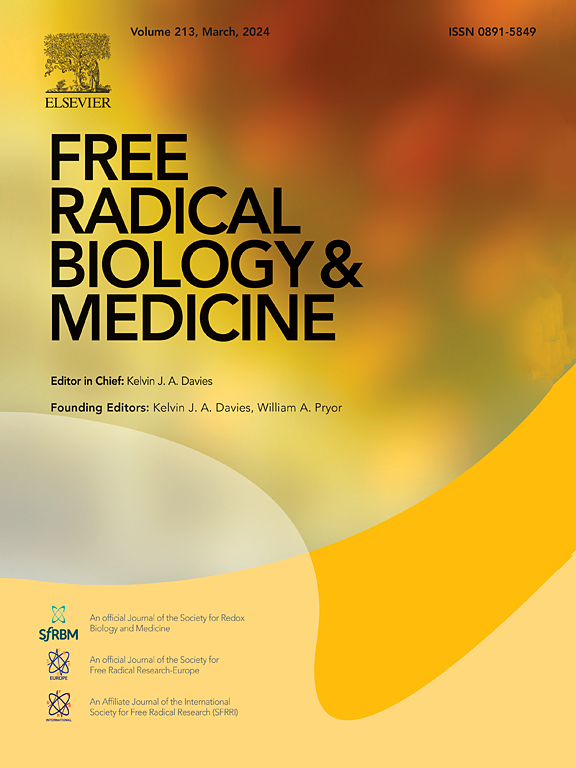Senescent cartilage endplate stem cells-derived exosomes induce oxidative stress injury in nucleus pulposus cells and aggravate intervertebral disc degeneration by regulating FOXO3
IF 7.1
2区 生物学
Q1 BIOCHEMISTRY & MOLECULAR BIOLOGY
引用次数: 0
Abstract
Intervertebral disc degeneration (IVDD) is the leading cause of low back pain and associated disability worldwide. The cartilage endplate (CEP) is a critical structure in maintaining the homeostasis of the intervertebral disc, by exosomes (Exos)-mediated intracellular communication between cartilage endplate stem cells (CESCs) and nucleus pulposus cells (NPCs). However, whether the senescence of CESCs influences the functionality of CESCs-derived Exos (CESCs-Exos) and participates in the progress of IVDD remains unclear. In this study, we explored the role and mechanism of the Exos-based intracellular communication between senescent CESCs and NPCs in IVDD. CESCs isolated from aged individuals (S-CESCs) exhibited high levels of senescence compared with CESCs isolated from young individuals (Y-CESCs). Exos from Y-CESCs (Y-Exos) and from S-CESCs (S-Exos) were extracted and identified. Surprisingly, we found that S-Exos lost the therapeutic effects as the Y-Exos exhibited in mitigating IVDD, and even aggravated IVDD by inducing oxidative stress injury in NPCs. MicroRNA-sequencing revealed significant upregulation of miR-29b-3p expression in S-Exos. Through microRNA target prediction, dual luciferase assays, RNA-sequencing, lentivirus-mediated overexpression and suppression, we demonstrated that miR-29b-3p regulates the expression of FOXO3 and downstream antioxidant enzymes to induce oxidative stress injury in NPCs. In vivo experiments further verified that countering miR-29b-3p by antagomir reversed the detrimental effects of S-Exos in exacerbating IVDD. This work elucidates the role and mechanism of senescent CESCs in disrupting redox homeostasis in the nucleus pulposus and exacerbating IVDD by Exos-mediated intracellular communication and offers an experimental foundation for the selection of proper CESCs-Exos to obtain better therapeutic effects in IVDD.

衰老软骨终板干细胞来源的外泌体通过调节FOXO3诱导髓核细胞氧化应激损伤并加重椎间盘退变。
椎间盘退变(IVDD)是世界范围内腰痛和相关残疾的主要原因。软骨终板(CEP)是维持椎间盘稳态的关键结构,通过外泌体(Exos)介导的软骨终板干细胞(CESCs)和髓核细胞(npc)之间的细胞内通讯。然而,CESCs的衰老是否会影响CESCs衍生Exos (CESCs-Exos)的功能并参与IVDD的进展尚不清楚。在这项研究中,我们探讨了衰老CESCs和NPCs之间基于exos的细胞内通讯在IVDD中的作用和机制。与从年轻个体分离的CESCs (Y-CESCs)相比,从老年个体分离的CESCs (S-CESCs)表现出更高的衰老水平。从Y-CESCs (Y-Exos)和S-CESCs (S-Exos)中提取并鉴定Exos。令人惊讶的是,我们发现S-Exos失去了Y-Exos减轻IVDD的治疗作用,甚至通过诱导npc氧化应激损伤加重了IVDD。microrna测序显示S-Exos中miR-29b-3p表达显著上调。通过microRNA靶点预测、双荧光素酶测定、rna测序、慢病毒介导的过表达和抑制,我们证明了miR-29b-3p调节FOXO3和下游抗氧化酶的表达,诱导npc氧化应激损伤。体内实验进一步证实,安他哥莫对抗miR-29b-3p逆转了S-Exos加重IVDD的有害作用。本研究阐明了衰老的cesc通过exos介导的细胞内通讯破坏髓核氧化还原稳态,加重IVDD的作用和机制,为选择合适的CESC-Exos以获得更好的IVDD治疗效果提供了实验基础。
本文章由计算机程序翻译,如有差异,请以英文原文为准。
求助全文
约1分钟内获得全文
求助全文
来源期刊

Free Radical Biology and Medicine
医学-内分泌学与代谢
CiteScore
14.00
自引率
4.10%
发文量
850
审稿时长
22 days
期刊介绍:
Free Radical Biology and Medicine is a leading journal in the field of redox biology, which is the study of the role of reactive oxygen species (ROS) and other oxidizing agents in biological systems. The journal serves as a premier forum for publishing innovative and groundbreaking research that explores the redox biology of health and disease, covering a wide range of topics and disciplines. Free Radical Biology and Medicine also commissions Special Issues that highlight recent advances in both basic and clinical research, with a particular emphasis on the mechanisms underlying altered metabolism and redox signaling. These Special Issues aim to provide a focused platform for the latest research in the field, fostering collaboration and knowledge exchange among researchers and clinicians.
 求助内容:
求助内容: 应助结果提醒方式:
应助结果提醒方式:


